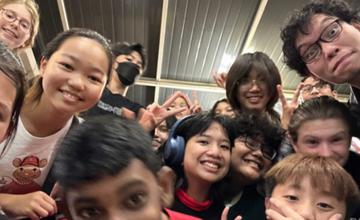Difference between bullying and peer conflict

May 14, 2018
Continuation from last month
So, what are the differences between Bullying and Peer Conflict
Bullying occurs when one or group of people deliberately cause any harm physically and/or psychologically to the victim. Not all physical and verbal aggression is bullying. It involves:
Types of Bullying:
In normal peer conflict:
How the interaction looks like for hassling, aggression, and bullying. Adapted from NZ Anti Bullying.

Malou Bromley, our Nexus Whole School Counsellor was the guest speaker on Stress Management in the Australian National Leaders' Summit, an initiative organised by the Malaysian Students’ Council of Australia, held in KDU. One of the student leaders who organised the event was our former learner Kenny Ng.
It was an interactive gathering which covered issues concerning parental pressures, healthy/unhealthy stress and the impact of culture, family and technology on stress and how to get through it.
For further information or for any parental related concerns you can contact Malou Bromley:
bromley.m@nexus.edu.my or +60 3 8889 3868
So, what are the differences between Bullying and Peer Conflict
Bullying occurs when one or group of people deliberately cause any harm physically and/or psychologically to the victim. Not all physical and verbal aggression is bullying. It involves:
- An imbalance of power due to physical size/strength, age, social status, and cyber abilities.
- The intimidation is repeated overtime or sometimes one off.
- An intention to seek power and/or materials e.g. money
- Strong emotional reaction from the victim and less or none from the bully
- The bully mainly blames the victim with no remorse.
Types of Bullying:
- Physical
- Verbal
- Relational Aggression or Emotional
- Cyber
- Sexual
- Prejudicial
In normal peer conflict:
- The peers have equal powers and mostly friends with each other
- It happens occasionally
- It can be unintentional remark but offensive to the receiver
- Both parties show remorse
- Both parties are willing to find solution and move on.
- It can start as hassling between friends that sometimes go a bit too far
- An aggressive reaction from provocation
- The restorative chat/mediation is more effective.
How the interaction looks like for hassling, aggression, and bullying. Adapted from NZ Anti Bullying.
| Hassling/Teasing | Aggression/Fighting | Bullying | |
| Does it go both ways? | Usually both individuals are hassling each other. | Not usually. One tends to initiate. | No. One person (or group of individuals) is targeting the other. |
| Does it look like they are having fun? | Usually takes place between two people (or group) who are familiar with, and like each other. | No. One is the aggressor. | No. One is in distress or traumatized. |
| Is it well meaning? | Yes, it’s usually good-natured hassling. | Not usually. It is often intentional but can be also be involuntary to something. | No. One is deliberately harming the other. |
| Is it one-off? | No. It’s usually on going because they hang out together. | Often a single incident. | No. It happens repeatedly overtime. |
| Is it between equal? | Yes. | Possibly. | No. There is an obvious power of imbalance. |

Malou Bromley, our Nexus Whole School Counsellor was the guest speaker on Stress Management in the Australian National Leaders' Summit, an initiative organised by the Malaysian Students’ Council of Australia, held in KDU. One of the student leaders who organised the event was our former learner Kenny Ng.
It was an interactive gathering which covered issues concerning parental pressures, healthy/unhealthy stress and the impact of culture, family and technology on stress and how to get through it.
For further information or for any parental related concerns you can contact Malou Bromley:
bromley.m@nexus.edu.my or +60 3 8889 3868


